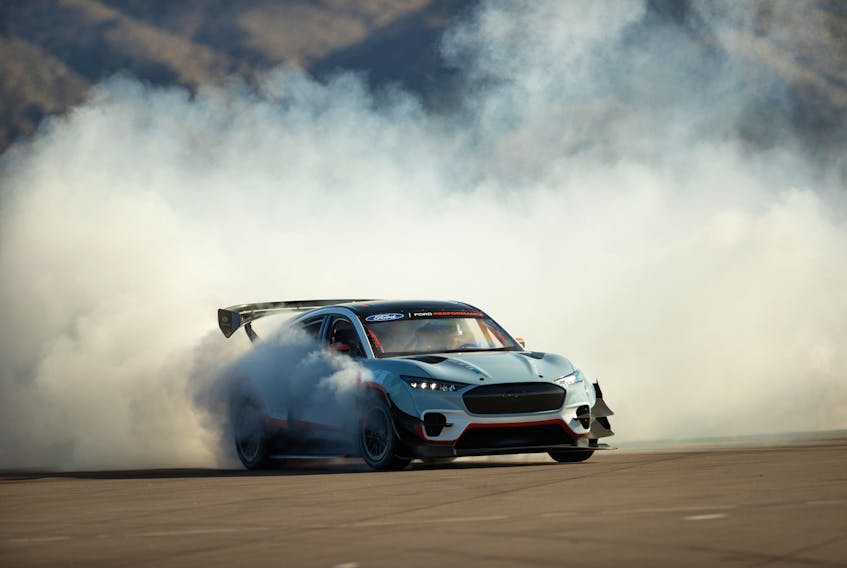David Booth
The first question I had for Vaughn Gittin Jr., founder of RTR motorsports and self-described “professional fun-haver” was, “you only have four wheels, so where in the H-E-double-hockey-sticks do you stuff seven motors?”
Yes, RTR’s latest monster hot-rod – a cooperative effort with Ford’s official performance division – has, according to their joint press release, seven electric motors. The Mustang Mach-E 1400 boasts a total of 1,400 brake horsepower. I’m not sure what’s more incredible.
Now, never mind that 1,400 horsepower is just plain silly or the fact that I’m sure Ford could have done better than averaging but 200 ponies per electric motor, the big question, efficient or not — hell, necessary or not — is where, in fact, do you locate seven propulsion devices when one only has four wheels to be, err, “propulsed”?
Well, the answer, according to Gittin, is that the 200-hp-per-unit axial flux motors are actually stackable – think rotors being conjoined, pancake-style, like multi-rotor Wankel engines of old – with four powering the rear axle and three motivating the front wheels. It’s an arrangement that allows this Mach-E to be configured in all-wheel, rear-wheel and front-wheel drive guises; I get the first two, but for the life of me, I can’t imagine why anyone would want a 600-hp, FWD race car.
Nonetheless, this versatility is key to the Mach-E 1400’s raison d’etre, as Gittin says this Mach-E can be quickly altered for drag racing, gymkhana and even drifting. Said configurability starts with the axles; while the RTR-tuned Mach-E doesn’t have a transmission per se, the rear axle ratios can be swapped out to alter final drive ratios, balancing the need for instantaneous acceleration and top speed.

Additionally, those same differentials can be removed to create the special “effects” each discipline requires. Drifting, of course, requires that all the power be directed to the rear tires for long, arcing sideways cornering, but as Gittin explains, the customization doesn’t end there. So when sideways smoke-shows are called for, RTR technicians also swap out the front A-arms to allow the 60-degrees of counter-steering that drifting requires. Gymakana, meanwhile, requires stronger tie-rods and yet again different suspension bits. The 1400 might not be as electronically-sophisticated as modern supercars but it’s no less adjustable. Throw in equally-configurable aerodynamics – the 1400 can generate more than 1,000 kilograms of downforce at 256 km/h – and this Mustang Mach-E is a multi-discipline track terror.
But that’s all standard stuff for a team that builds cars like Ken Block’s famed Hoonicorn. More difficult was engineering the energy storage system – that would be the battery – to be able to cope with the demands of seven motors. Simply put, engineering a battery and invertor combination that could dump the incredible current required to generate 1,400 horsepower was something all new to a team that was used to solving the issues specific to internal combustion.
So, the custom 56.8 kWh nickel manganese cobalt Lithium-ion pouches (the individual cells that make up the battery) were specifically chosen for their ultra-high discharge rate. Even more important, says Gitten, is keeping the entire powertrain cool. So not only is di-electric coolant circulated through the battery during fast charging (so the 1400 can put on yet another demonstration for adoring crowds), but the invertor is cooled by a traditional water/glycol mix and the electric motors by a constantly refreshed bath of oil. Without such cooling, says Mr. Fun-Haver, the 45-minute demonstrations that Ford and RTR have planned for the Mustang Mach-E 1400 wouldn’t be possible.
Of course, all this craziness is in support of the production Mustang Mach-E, which Ford is hoping will challenge Tesla’s Model Y for electric SUV supremacy. Look for it – without seven electric motors – in Ford dealerships later this year.

Copyright PostMedia Network, 2020









